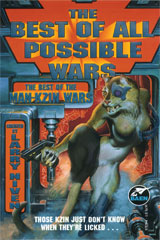
This book was conceived in a casual encounter. Marilyn and I were driving to a Nebula Awards banquet with Jim Baen in the back seat. She drove, we talked . . .
I knew about franchise universes. Jim and I had edited The Magic May Return and More Magic, tales set in the Magic Goes Away universe but written by friends whom we had invited in. I had played in neighbors' playgrounds, too. "A Snowflake Falls" used Saberhagen's "Berserkers," by invitation. I'd written a tale set at Lord Dunsany's "edge of the world," and a report on the year the Necronomicon hit the college campuses in paperback, and a study of Superman's fertility problems.
I've never been in a war, nor in any of the armed forces. Wars have happened and may happen again in most of my series universes, including Known Space, but you'll never see them. I lack the experience. Here are a couple of centuries of Known Space that are dark to me.
By the time we parked, Jim and I had agreed to open up the Man-Kzin Wars period of Known Space.
Any writer good enough to be invited to play in my universe will have demonstrated that he can make his own. Would anyone accept my offer? I worried also that intruders might mess up the playground, by violating my background assumptions.
But I did want to read more tales of Known Space . . . and I hadn't written any in years.
For the Warlock's era I had written a "bible," a set of assumptions, list of available characters, backgrounds, a few story ideas. For the Man-Kzin Wars the "bible" was already written, by John Hewitt for the Chaosium role-playing game, "Ringworld." I photocopied the appropriate pages, with his permission and Chaosium's.
I did not anticipate what happened.
I had to turn down one story outline and one completed story. It didn't matter. Poul and Dean both turned in 40,000-word novellas! And now they're talking about sequels.
It's as if you can't say anything short in the Known Space universe.
I guess I'm flattered. And I surely got my wish. These stories read like good Poul Anderson, and good Dean Ing, and good Niven; and Niven couldn't have written them.
from Man-Kzin Wars, Vol. I
"The Warriors" wasn't just the first tale of the kzinti. It was the first story I ever offered for sale. I was daydreaming in math class, as usual, and I realized that I'd shaped a complete story. So I wrote it down, and bought some magazines to get the editorial addresses, and started it circulating.
It was years before anyone bought it. By then I'd rewritten it countless times, trying out what I was learning from my correspondence writing course. Fred Pohl (editor of Galaxy and Worlds of If in those days) saw it often enough that he eventually wrote, "I think this can be improved . . . but maybe you're tired of reworking it, so I'll buy it as is . . ." It was probably his title, too.
The kzinti look a little blurred here, don't they? I mean, if you've known them elsewhere. Subsequently they changed in several ways.
I learned to answer John W. Campbell's challenge: "Show me something that thinks as well as a man, or better, but not like a man." The kzinti took on more detail, gained greater consistency and lost some of their resemblance to humanity. They were born as one of a thousand catlike aliens in science fiction. As I learned how to make an alien from basic principles, body and mind and soul, the kzinti became more themselves.
At the same time they were changing in another way, evolving over several centuries. The Man-Kzin Wars changed them far more than they changed mankind, because the wars killed off the least intelligent and most aggressive.